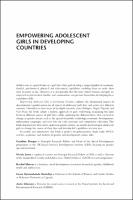Empowering Adolescent Girls in Developing Countries
Proposal review
Gender Justice an Norm Change
| dc.contributor.editor | Kyomuhendo Bantebya, Grace | |
| dc.contributor.editor | Jones, Nicola | |
| dc.contributor.editor | Ghimire, Anita | |
| dc.contributor.editor | Marcus, Rachel | |
| dc.contributor.editor | Harper, Caroline | |
| dc.date.accessioned | 2018-02-01 23:55:55 | |
| dc.date.accessioned | 2019-10-18 14:18:35 | |
| dc.date.accessioned | 2020-04-01T13:03:21Z | |
| dc.date.available | 2020-04-01T13:03:21Z | |
| dc.date.issued | 2018 | |
| dc.identifier | 644645 | |
| dc.identifier | OCN: 1019657346 | en_US |
| dc.identifier.uri | http://library.oapen.org/handle/20.500.12657/30629 | |
| dc.description.abstract | Adolescence, wherever you live, is a potentially turbulent and challenging time and no less so in the four countries where we undertook our work. Here, transitions through adolescence are fraught with difficulties, in part due to the deeply embedded gender norms which determine what a girl can and cannot do and how she must be. Each specific context came with its own factors: multi-ethnic and multi-religious communities, remoteness, variable services (if any at all) and, sometimes, a policy and cultural context without recognition of adolescence, where the transition to adulthood is short or immediate rather than prolonged. Nevertheless, what we know from biological sciences is that adolescence is a developmental period – a time when the body and mind changes. These changes bring with them potential which in the right context, can open new opportunities. Our interest was in exploring that potential and how gendered norms might truncate opportunities and limit the development of capabilities which every young adult could aspire to own – the ability to have a political voice, to be educated, to be in good health, to have control over one’s body, to be free from violence, to be able to own property and earn a livelihood, to be economically and politically empowered. We were intrigued by the very common experiences of adolescent girls across multiple contexts. This learning and sharing enabled us to explore in much greater depth what norms are and how they operate within political and institutional spaces at national and community levels. It also allowed us to explore the changing and different conceptual understandings of gendered social relations, gender equality and the usage of the term ‘norm’ to capture embedded, often implicit, informal rules by which people abide, and which are bound into the values people and societies accept implicitly, accept reluctantly or actively contest. | |
| dc.language | English | |
| dc.subject.classification | thema EDItEUR::J Society and Social Sciences::JH Sociology and anthropology::JHM Anthropology | en_US |
| dc.subject.other | justice | |
| dc.subject.other | developing countries | |
| dc.subject.other | gender | |
| dc.subject.other | girls | |
| dc.subject.other | adolescence | |
| dc.subject.other | norm change | |
| dc.subject.other | Child marriage | |
| dc.subject.other | Hmong people | |
| dc.subject.other | Nepal | |
| dc.subject.other | Social norm | |
| dc.subject.other | Uganda | |
| dc.subject.other | Vietnam | |
| dc.title | Empowering Adolescent Girls in Developing Countries | |
| dc.title.alternative | Gender Justice an Norm Change | |
| dc.type | book | |
| oapen.relation.isPublishedBy | 7b3c7b10-5b1e-40b3-860e-c6dd5197f0bb | |
| oapen.relation.isbn | 9781138747166;9781315180250 | |
| oapen.imprint | Routledge | |
| oapen.pages | 228 | |
| oapen.remark.public | Relevant Wikipedia pages: Adolescence - https://en.wikipedia.org/wiki/Adolescence; Child marriage - https://en.wikipedia.org/wiki/Child_marriage; Gender equality - https://en.wikipedia.org/wiki/Gender_equality; Gender role - https://en.wikipedia.org/wiki/Gender_role; Hmong people - https://en.wikipedia.org/wiki/Hmong_people; Nepal - https://en.wikipedia.org/wiki/Nepal; Social norm - https://en.wikipedia.org/wiki/Social_norm; Uganda - https://en.wikipedia.org/wiki/Uganda; Vietnam - https://en.wikipedia.org/wiki/Vietnam | |
| oapen.remark.public | 21-7-2020 - No DOI registered in CrossRef for ISBN 9781138747159 | |
| oapen.identifier.ocn | 1019657346 | |
| peerreview.anonymity | Single-anonymised | |
| peerreview.id | bc80075c-96cc-4740-a9f3-a234bc2598f1 | |
| peerreview.open.review | No | |
| peerreview.publish.responsibility | Publisher | |
| peerreview.review.stage | Pre-publication | |
| peerreview.review.type | Proposal | |
| peerreview.reviewer.type | Internal editor | |
| peerreview.reviewer.type | External peer reviewer | |
| peerreview.title | Proposal review | |
| oapen.review.comments | Taylor & Francis open access titles are reviewed as a minimum at proposal stage by at least two external peer reviewers and an internal editor (additional reviews may be sought and additional content reviewed as required). |

